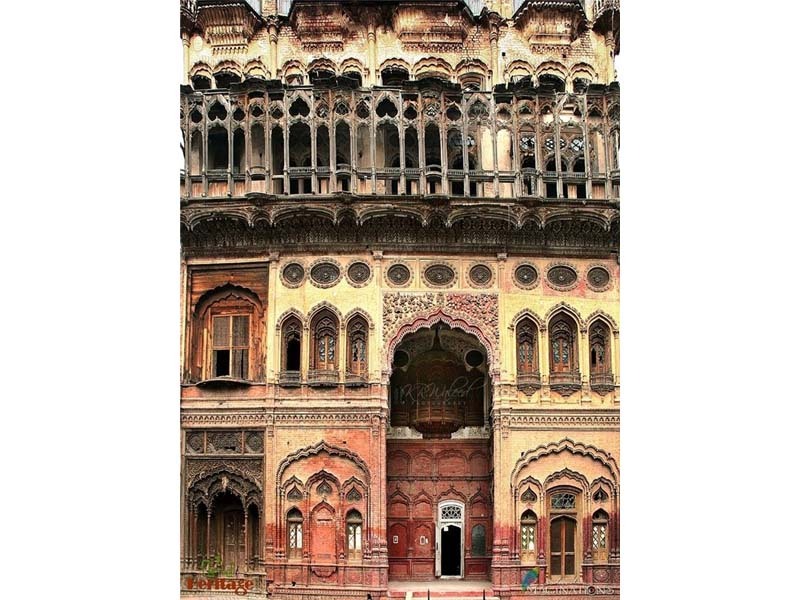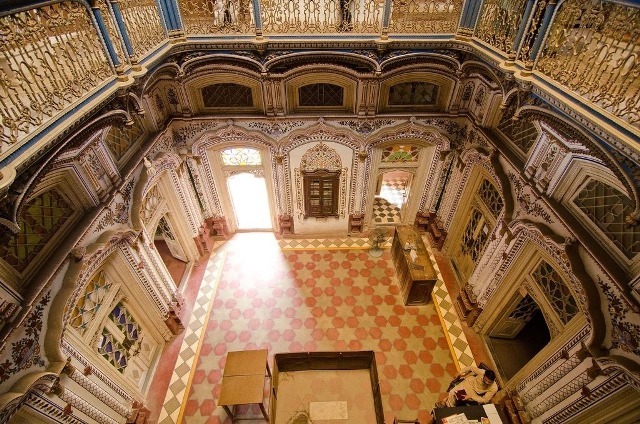
Punjab has a variety of magnificent historical buildings and folklore associated with the extraordinary structures. Omar Hayat Mahal in Chiniot is one such edifice that flaunts its majesty and aesthetics though local legends call it a harbinger of ruination for anyone who lives in it.
Legend has it that the grand palace was ordered to be built by a famous Kolkata-based businessman, Sheikh Omar Hayat, for his family in 1935 and right before the construction was complete, he passed away. In the same period, his daughter Haseena succumbed to tuberculosis.
The grieving family, including Omar’s widow, Fatima, and son, Gulzar, moved into the residence two years after his death. Gulzar’s wedding was fixed and the family hoped for a fresh start but he died of carbon monoxide poisoning the very next day after the ceremony.
His mother disallowed a funeral and got him buried inside the palace and she too passed away a year later due to trauma.
The serial tragedy led the Sheikh family to believe that the building was jinxed and they abandoned it.
Sheikh Mohammad Rafi, an elder from Chiniot, said that the owner of the palace died before he could shift in it and his family passed away soon after, therefore, everyone feels the place has an evil vibe to it.
As per records, after the owners left the building was used as children’s home 1940 onwards till its dilapidated condition forced the orphanage’s administration to relocate.

About half a century later, in 1989, the government declared the palace, spread over 3,267 square feet, a heritage site.
Omar Hayat Mahal is also known as the TajMahal of Chiniot. Just like the TajMahal, it is unique in its glory and sadly both serve as a burial ground for the notables.
The distinctive construction of the palace has attracted thousands of tourists over the years. This masterpiece of architecture took around 12 years to complete at a cost of approximately Rs400,000.
Intricate woodwork on doors, windows, staircases, arches, columns and railings demonstrates the local expertise of Chiniot- the centuries-old wood carving art and fretwork.
Colourful frescos, decorated ceilings and elaborate rooms also captivate the imagination of visitors who are amazed by the grace and grandeur of the edifice.
The structure, boasting a large basement and five beautifully planned floors, was designed by UstadElahiBakhsh, a famous architect of yesteryears.
Two plaques grace the entrance of the palace, one bears the name of UstadElahiBaksh and his fellow artisans, while the other states the names of those who repaired it in later years.
Mohammad Athar, a former deputy commissioner of Jhang, spent Rs1.7 million for the palace’s reconstruction in his tenure after it had lost two floors. In June 1990, a museum displaying items used by the Sheikh family was set up inside in a room that was opened for public.
Then on a library with around 10,000 books was established inside the palace which is now in a poor condition.
The palace's custodian and library in-charge for the past three decades, Mushtaq Ahmed, said if the government provides Rs1 million annually, the cultural heritage can be preserved.

“It can become the center of attention for domestic and foreign tourists,” he remarked.
The officials in the departments of Archeology and Tourism told The Express Tribune that the provincial government has not assigned the custody of the heritage site to them.
It seems that the incumbent government is oblivious to the tourism potential of this palace.
Chiniot Deputy Commissioner Mohammad Riaz said, “We do not have the finances to afford renovation of this building.”
“The library and museum are administered by the Municipal Corporation. Though, we pay the electricity bill, newspaper dues and employees’ salary of this palace which costs us around Rs250,000 per month,” he maintained, adding, “This is all we can manage under the tight budget.”
1736816645-0/Elon-Musk-(3)1736816645-0-405x300.webp)


1737286368-0/trump-(1)1737286368-0-165x106.webp)







1737185197-0/Express-Tribune-(2)1737185197-0-270x192.webp)
1737188551-0/Untitled-design-(97)1737188551-0-270x192.webp)



1737114296-0/Express-Tribune---News-Desk-(4)1737114296-0-270x192.webp)






COMMENTS
Comments are moderated and generally will be posted if they are on-topic and not abusive.
For more information, please see our Comments FAQ